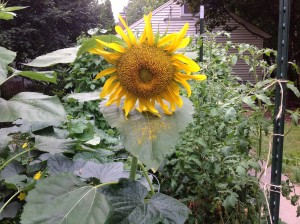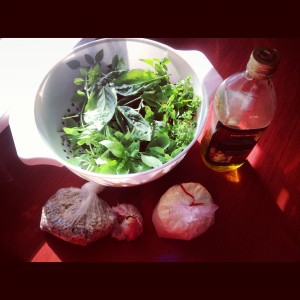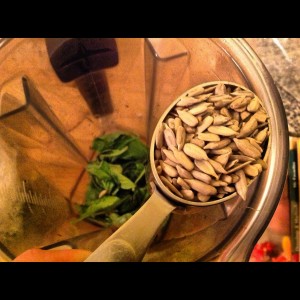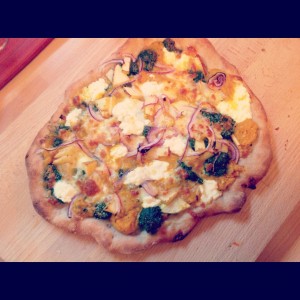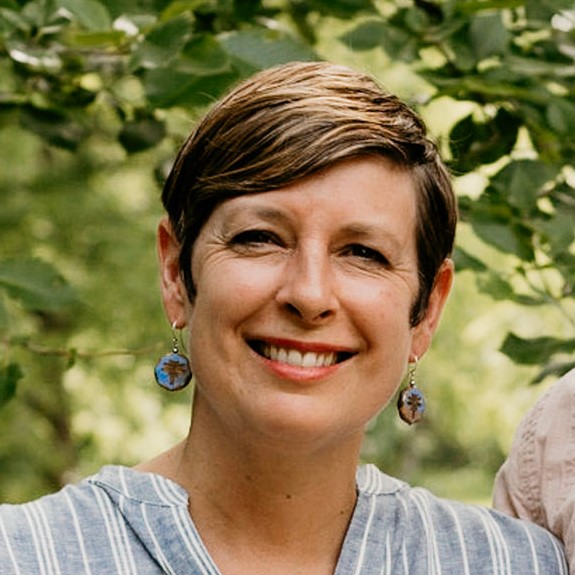Most of us know that Vitamin D is the “sunshine” vitamin but what you may not know is that Vitamin D can be found naturally in a few specific foods: fortified foods such as dairy products, fatty fishies such as canned sardines, herrings, and tuna, fish oils, liver, offal, egg yolks, shellfish, pumpkin seeds, flax seeds and sunflower seeds. While I should be clear that the levels of Vitamin D that are found in these foods are are not very high, and we still need to get out in the sun and in some cases supplement this important Vitamin, its worth knowing about those foods such as sunflower seeds that contain Vitamin D.
Enter a good friend of the sunflower seed, basil, specifically the basil in my garden and yours that is about to be annihilated by the first frost. Leafy greens contain calcium and basil is no exception. The thing is that our body must have Vitamin D to absorb calcium and promote bone growth. These two ingredients go hand and hand: calcium is needed for strong bones, but your body cannot absorb it properly without the help of Vitamin D. The combination of calcium and Vitamin D increases bone mineral density and decreases fractures. Which brings me to pesto……
A couple of weeks ago we were perilously close to the first frost and outside the Twin Cities some farmers did get zapped. While some veggies benefit from a first frost (e.g., Kale), basil just plain dies. Picture basil basking on the beach in Liguria, lazily sunning itself before taking an unhurried passegiata down to a seaside hosteria where it happily leaps in slow motion into a bowl of pasta to meet its life-has-been-good-to-me demise. Envision the same basil stepping outside into the brutal cold after landing at the Minneapolis airport and doing a lot of crying and sulking. It’s the primadonna of herbs and is very touchy about this Minnesota climate. It’s exactly the right time to harvest all that basil before it dies and put up a little bit of tasty sunshine that can nourish your body through the winter. When the dead of January is upon you, finding a little jar of sunflower pesto in the corner of your freezer brings the kind of joy that only those from very cold climates can understand.
Sunflower seeds meld beautifully in pesto for many reasons:
- Sunflower seeds are inexpensive – especially when compared with the pine nut.
- Sunflower seeds are relatively local – I went to high school in Enderlin, ND, proudly named, “The Sunflower Capital of the World”.
- Sunflower seeds are a source of Vitamin D – as is liver – pate anyone?
- Sunflower seeds are delicious – take me out to the ball game!
Here’s a basil pesto recipe from my Vitamix recipe booklet adapted with the swapping out of sunflower seeds for pine nuts. Utilize a local parmesan cheese like the award-winning Sartori SarVecchio Parmesan and you’ve got a delicious, inexpensive, local pesto that you can freeze and enjoy throughout the winter. As for me and my house, we love to put dollops of the stuff on home-made pizza.
Pizza topped with Sunflower pesto, Buttercup Squash,
Haralson Apples, and Donnay Dairy Fresh Goat Cheese
Pesto Sauce – Recipe yields enough sauce to coat 1 pound of pasta
½ cup olive oil
½ cup grated Parmesan cheese
2 medium garlic cloves
2 cups fresh basil leaves
2 tablespoons sunflower seeds
Salt and pepper to taste
1) place all ingredients, except salt and pepper, into the Vita-Mix or your own blender in the order listed and secure lid.
2) Turn machine on and quickly increase the speed.
3) Blend until desired consistency (smooth and creamy or a bit on the rustic side).
I like to put my pesto in little glass jelly jars or plastic Ball freezer jars and then freeze those jars in ziplock bags for extra protection from freezer frost. Alternatively you can mush the pesto into ice cube trays and then pop out the pesto chunks and freeze those in ziplock bags.
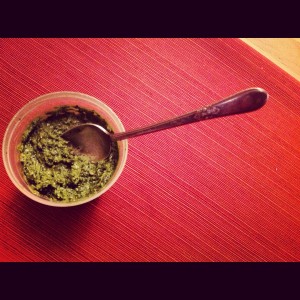 This is a recipe you can really go seeds over (hehehe – see what I did there?) in that you can experiment with other seeds such as pumpkin seeds and different leafy greens or herbs like spinach or kale. For example, you could lose the cheese and go more of a Latin route with cilantro, pumpkin seeds, and some lime zest.
This is a recipe you can really go seeds over (hehehe – see what I did there?) in that you can experiment with other seeds such as pumpkin seeds and different leafy greens or herbs like spinach or kale. For example, you could lose the cheese and go more of a Latin route with cilantro, pumpkin seeds, and some lime zest.
There’s a kind of logic here that I care a lot about: that it makes sense for those of us in the northern reaches of the planet to seek out those local foods that contain Vitamin D; that we should know more about the foods that grow outside in our backyards and learn how to utilize them in our own kitchens. But when all is said and done, let’s just do our part to save that primadonna of herbs and give her something to do out here in the tundra.

